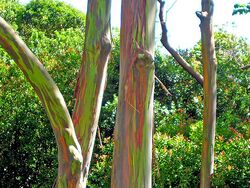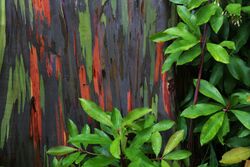Biology:Eucalyptus deglupta
| Rainbow eucalyptus | |
|---|---|

| |
| Eucalyptus deglupta bark on young trees in Hawaii | |
| Scientific classification | |
| Kingdom: | Plantae |
| Clade: | Tracheophytes |
| Clade: | Angiosperms |
| Clade: | Eudicots |
| Clade: | Rosids |
| Order: | Myrtales |
| Family: | Myrtaceae |
| Genus: | Eucalyptus |
| Species: | E. deglupta
|
| Binomial name | |
| Eucalyptus deglupta | |
| Synonyms[2] | |
| |
Eucalyptus deglupta is a species of tall tree, commonly known as the rainbow eucalyptus,[3] Mindanao gum, or rainbow gum[4] that is native to the Philippines , Indonesia, and Papua New Guinea. It is the only Eucalyptus species that usually lives in rainforest, with a natural range that extends into the Northern Hemisphere. It is characterized by multi-colored bark.
Description


Eucalyptus deglupta is a fast-growing tree that typically reaches a height of 60–75 m (197–246 ft) with the trunk up to 240 cm (94 in) in diameter and with buttresses up to 4 m (13 ft) high. It has smooth, orange-tinted bark that sheds in strips, revealing streaks of pale green, red, orange, grey, and purplish brown. The branchlets are roughly square in cross section, often with narrow wings on the corners. The leaves are arranged in opposite pairs, mostly 75–150 mm (3–6 in) long and 50–75 mm (2–3 in) wide on a short petiole. The flower buds are arranged in a branching inflorescence in leaf axils, or on the end of branchlets, each branch with groups of seven buds, the individual buds on a pedicel about 5 mm (3⁄16 in) long. Mature buds are pale green or cream-colored, roughly spherical in shape and 2–5 mm (1⁄16–3⁄16 in) in diameter with a hemispherical operculum with a small point on the top. Flowering time depends on location, and the stamens that give the flowers their colour are white and pale yellow. The fruit is a woody, brown, hemispherical capsule about 3–5 mm (1⁄8–3⁄16 in) long and wide, with three or four valves extending beyond the rim of the fruit. Each cell of the fruit contains between three and twelve minute brown seeds, each with a small wing.[5][6]
Taxonomy and naming
Eucalyptus deglupta was first formally described in 1850 by Carl Ludwig Blume who published the description in his book Museum Botanicum Lugduno-Batavum sive stirpium Exoticarum, Novarum vel Minus Cognitarum ex Vivis aut Siccis Brevis Expositio et Descriptio from material collected in mountain forests in the Celebes.[2][7] The specific epithet (deglupta) is a Latin word meaning "peeled off, husked or shelled".[8]
In 1914, Adolph Daniel Edward Elmer described Eugenia binacag in Leaflets of Philippine Botany, the specific epithet binacag a local name for the tree,[9] but in 1915 changed the name to Eucalyptus binacag.[10] However, the species had already been named E. deglupta by Blume in 1850 and E. binacag is now regarded as a synonym.[2]
In 1854, Asa Gray described Eucalyptus multiflora in United States Exploring Expedition - Botany, Phanerogamia from an unpublished description by Louis Claude Richard,[11][12] but is a nomen illegitimum because the name was already in use for a different species (Eucalyptus multiflora Poir.) now known as Eucalyptus robusta.[13] Eucalyptus multiflora is also a synonym of E. deglupta.[2]
Eucalyptus sarassa and E. versicolor, first described in 1850 by Blume in his book Museum botanicum Lugduno-Batavum,[14] and E. schlechteri first described by Ludwig Diels in Adolf Engler's book Botanische Jahrbücher für Systematik, Pflanzengeschichte und Pflanzengeographie[15] are also considered to be synonyms of E. deglupta by Plants of the World Online.[2]
Distribution and habitat
The rainbow eucalyptus grows in lowland and lower montane rainforest from sea level to altitudes of up to 1,800 m (5,900 ft). It is native to Indonesia, Papua New Guinea, and the Philippines, but has been widely planted in many other countries.[2]
The populations of this species are severely fragmented in the wild and the overall population is decreasing. Over the last 210 years it is estimated that there has been a 30% decline of the overall population. The International Union for the Conservation of Nature listed E. deglupta as a vulnerable species in 2019.[1]
Uses
Pulpwood
This tree is grown widely around the world in tree plantations, mainly for pulpwood used in making white paper. It is the dominant species used for pulpwood plantations in the Philippines .[16][17]
Use in horticulture

E. deglupta are commonly planted as ornamental trees in frost-free climates such as Hawaii, Southern California, Texas and Florida.[18] It is planted in at least three locations in coastal Los Angeles County, including Santa Monica and San Marino at the Huntington Botanical Garden. These trees were still growing, but relatively young at approximately 30–40 years in 1988, at the UCLA Botanic Garden and as a LA City street tree.[19]
If grown from seed, the temperature should be around 68–72 °F (20–22 °C).[20] Plants can be grown from cuttings of trees younger than 5 years old. Once a tree reaches 5 years of age, root inhibition prevents the generation of roots from cuttings.[21] It thrives in rich medium-to-wet soil in full sun and is intolerant of frost.[22] In botanical gardens such as Fairchild Tropical Botanic Garden in Florida, the tree does show the intense color range as seen in the tree's normal range.[23][24]
References
- ↑ 1.0 1.1 Hills, R. (21 June 2019). "Rainbow Eucalyptus Eucalyptus deglupta". IUCN Red List of Threatened Species 2019: e.T61911798A61911825. doi:10.2305/IUCN.UK.2019-3.RLTS.T61911798A61911825.en. https://www.iucnredlist.org/species/61911798/61911825. Retrieved 21 June 2023.
- ↑ 2.0 2.1 2.2 2.3 2.4 2.5 2.6 "Eucalyptus deglupta". Plants of the World Online. https://powo.science.kew.org/taxon/urn:lsid:ipni.org:names:592872-1#synonyms.
- ↑ "Eucalyptus deglupta" (in en). California Polytechnic State University. https://selectree.calpoly.edu/tree-detail/eucalyptus-deglupta.
- ↑ "Rainbow Gums". CSIRO. 18 September 2012. https://blog.doublehelix.csiro.au/rainbow-gums/.
- ↑ "Eucalyptus deglupta". World of Forestry. https://www.worldagroforestry.org/treedb/AFTPDFS/Eucalyptus_deglupta.PDF.
- ↑ "Eucalyptus deglupta". Missouri Botanical Garden. http://www.missouribotanicalgarden.org/PlantFinder/PlantFinderDetails.aspx?taxonid=282890.
- ↑ Blume, Carl Ludwig (1850). Museum Botanicum Lugduno-Batavum sive stirpium Exoticarum, Novarum vel Minus Cognitarum ex Vivis aut Siccis Brevis Expositio et Descriptio. pp. 83–84. https://www.biodiversitylibrary.org/item/192635#page/95/mode/1up. Retrieved 28 May 2019.
- ↑ Brown, Roland Wilbur (1956). The Composition of Scientific Words. Washington, D.C.: Smithsonian Institution Press. p. 716.
- ↑ Elmer, Adolph D.E. (1914). "Myrtaceae from Mount Urdaneta". Leaflets of Philippine Botany 7: 2351–2352. https://www.biodiversitylibrary.org/item/6766#page/34/mode/1up. Retrieved 9 October 2020.
- ↑ Elmer, Adolph D.E. (1915). "Two Hundred Twenty Six New Species - II". Leaflets of Philippine Botany 8: 2776. https://www.biodiversitylibrary.org/item/6767#page/60/mode/1up. Retrieved 9 October 2020.
- ↑ "Eucalyptus multiflora". Plants of the World Online. https://powo.science.kew.org/taxon/urn:lsid:ipni.org:names:593148-1.
- ↑ Gray, Asa (1854). United States Exploring Expedition - Botany, Phanerogramia, Part 1. Philadelphia: C. Sherman. pp. 554–555. https://www.biodiversitylibrary.org/page/40382252#page/559/mode/1up. Retrieved 10 October 2020.
- ↑ "Eucalyptus robusta". Australian Plant Census. https://biodiversity.org.au/nsl/services/apc-format/display/58105.
- ↑ Blume, Carl Ludwig (1850). Museum botanicum Lugduno-Batavum. New York: E.J. Brill. p. 84. https://www.biodiversitylibrary.org/item/192635#page/96/mode/1up. Retrieved 10 October 2020.
- ↑ Diels, Ludwig (1922). Botanische Jahrbücher für Systematik, Pflanzengeschichte und Pflanzengeographie. Leipzig: Wilhelm Engelmann. p. 423. https://www.biodiversitylibrary.org/item/720#page/430/mode/1up. Retrieved 10 October 2020.
- ↑ "Notes on Eucalyptus". National Resources Institute. http://www.nri.org/biomass/conference_papers/notes_on_eucalypts.pdf.
- ↑ Carroll, Jackie. "Eucalyptus". https://www.gardeningknowhow.com/ornamental/trees/eucalyptus/rainbow-eucalyptus-tree.htm.
- ↑ "Rainbow Eucalyptus Tree – Learn About Rainbow Eucalyptus Growing Conditions" (in en-US). https://www.gardeningknowhow.com/ornamental/trees/eucalyptus/rainbow-eucalyptus-tree.htm.
- ↑ Hodel, Donald R. (1988). Exceptional trees of Los Angeles (1st ed.). Arcadia, California: California Arboretum Foundation. p. 31. ISBN 0962112100.
- ↑ Caines, Kimberley. "Germination of a Eucalyptus Deglupta". https://homeguides.sfgate.com/germination-eucalyptus-deglupta-22711.html.
- ↑ Davidson, John (1973). "Reproduction of Eucalyptus deglupta by cuttings". New Zealand Journal of Forestry Science 4: 191–204. https://www.scionresearch.com/__data/assets/pdf_file/0007/30967/NZJFS421974DAVIDSON191_203.pdf.
- ↑ "Eucalyptus deglupta - Plant Finder" (in en-US). http://www.missouribotanicalgarden.org/PlantFinder/PlantFinderDetails.aspx?taxonid=282890.
- ↑ Garner, LariAnn. "Under the Rainbow". http://eucalyptusdeglupta.com/rainbowarticle.pdf.
- ↑ David Webster Lee (2007). Nature's palette: the science of plant color. University of Chicago Press. p. 228. ISBN 9780226471051. https://books.google.com/books?id=M3e5wyFJY-8C&pg=PA228. Retrieved 2011-04-22.
Wikidata ☰ Q2704355 entry
 |


